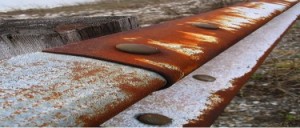By Kendall Smith, Induron Sales Rep
 Let’s face it: when you’re trying to overcoat aged, failing coatings, badly weathered galvanized steel or even rusted carbon steel, linseed oil as a barrier coating needs all the fortification it can get.
Let’s face it: when you’re trying to overcoat aged, failing coatings, badly weathered galvanized steel or even rusted carbon steel, linseed oil as a barrier coating needs all the fortification it can get.
Granted, modified linseed oil provides maximum wetting and penetration properties, as well as minimum curing stresses and disruption of the existing coating. But by itself, as a barrier coating, it would not hold out long against the elements (wind, rain, salt fog, sun, etc.).
So how do you get maximum barrier protection out of one high-build coat of modified linseed oil? Ask for it in the specification!
One purpose of a coatings specification is to be specific about what you want. High-build, properly pigmented linseed oil coatings have been providing excellent corrosion protection for 50 years when pigmented with functional pigments that provide an effective shield or barrier. Historically, once lead pigments were removed, those barrier properties have been best achieved with combinations of metallic zinc dust and other lamellar pigments, such as micaceous iron oxide and leafing aluminum.
When zinc is not used as galvanic protection (and at any concentration below 83 percent, it does NOT), it is best supplemented with platy-type pigments that orient themselves parallel with the substrate and overlap. These lamellar pigments align themselves much like mica. This lamellar formation creates a difficult pathway for the elements of corrosion to migrate through the system, and stops them from camping out on the vulnerable substrate, where corrosion cells will form and develop into pitting corrosion if moisture, salts and other corrosion inducers are left for any time at all.
So how do you write a specification and get maximum wetting, thickness, labyrinth-effect and corrosion protection in one coat of paint? It might be easier to first list a few ways NOT to specify an overcoating material for weathered galvanized steel:
1) Contractor shall use a good tower paint.
2) Contractor shall use a linseed oil high-build paint.
3) Contractor shall use a zinc dust linseed oil paint.
4) Contractor shall use a modified linseed oil zinc dust/ MIO tower paint.
Each of these four specifications get increasingly specific, but just aren’t specific enough. We suggest you go even further to get the exact material that has maximized its protective barrier properties:
5) Contractor shall use a modified linseed oil coating pigmented with metallic zinc dust and a lamellar type pigment such as micaceous iron oxide. The percentage of the combined zinc/MIO shall be a minimum of 35-40% by weight of the coating. When specifying micaceous iron oxide, the percentage shall be 20-25% hematite micaceous iron oxide, Grade I, which requires the highest degree of quality, specific composition, particle size range, particle shape and how the pigment is produced.
This gives you the maximum percentage of thin, flake-like particles, which form overlapping layers that lie roughly parallel to the substrate, and helps impede the corrosion promoters. It also strengthens the coating film. Get the most for your money by asking for it specifically! Ask your Induron rep to help you reference ISO 10601:2007 to get maximum barrier protection for your next transmission tower painting or overcoating job!




